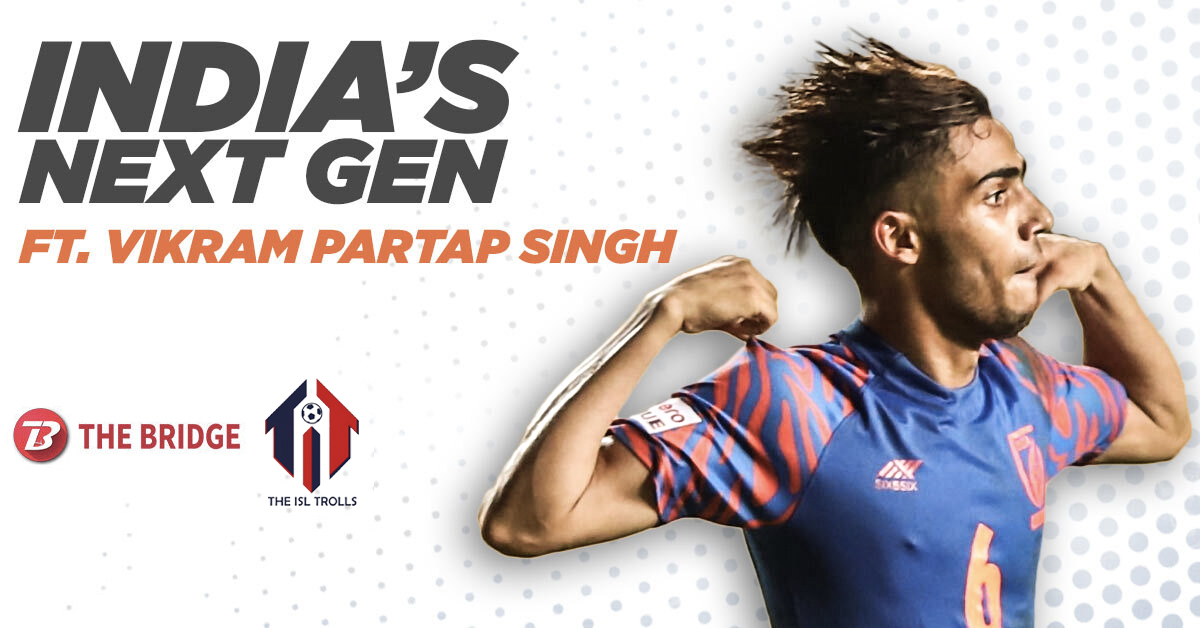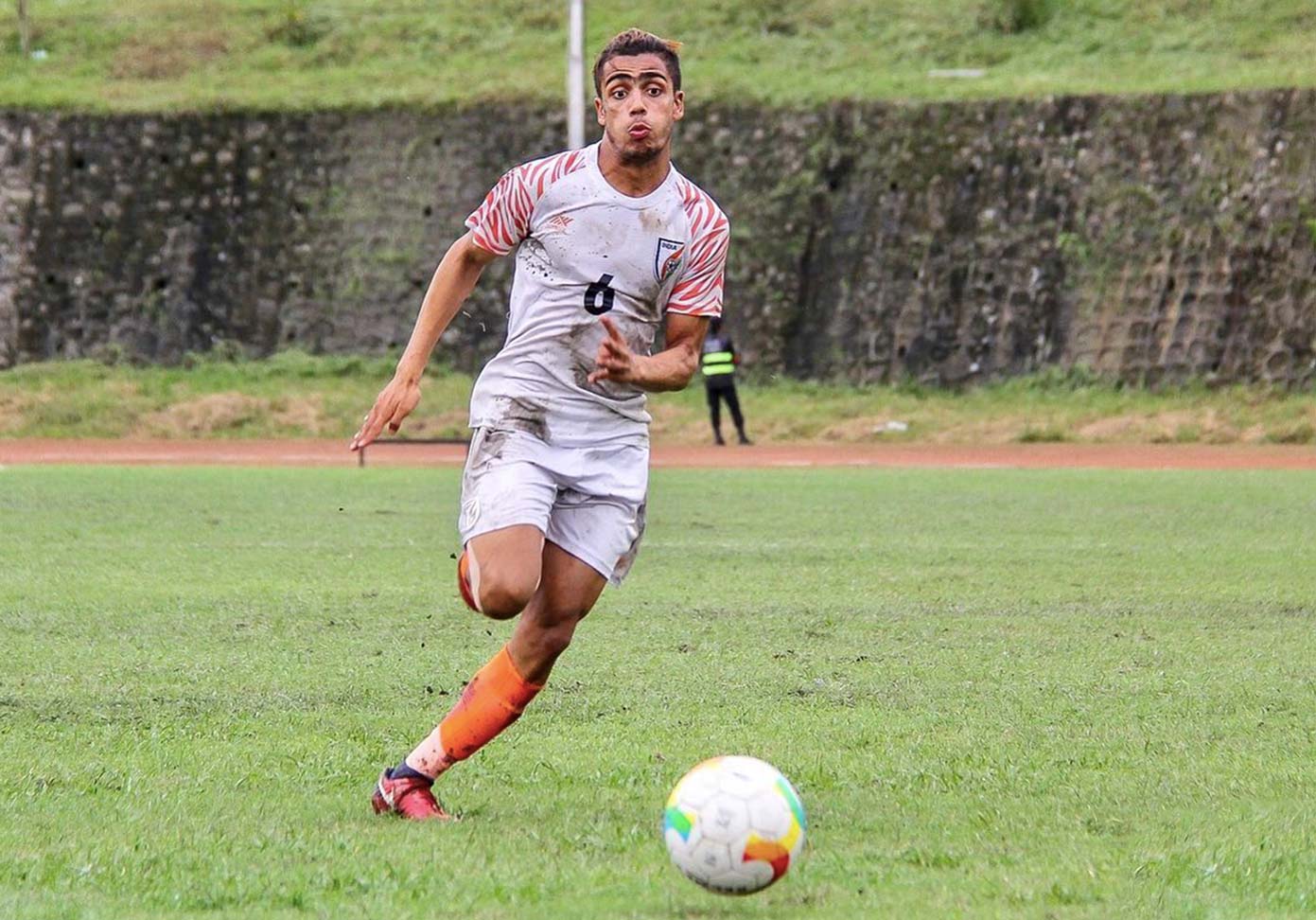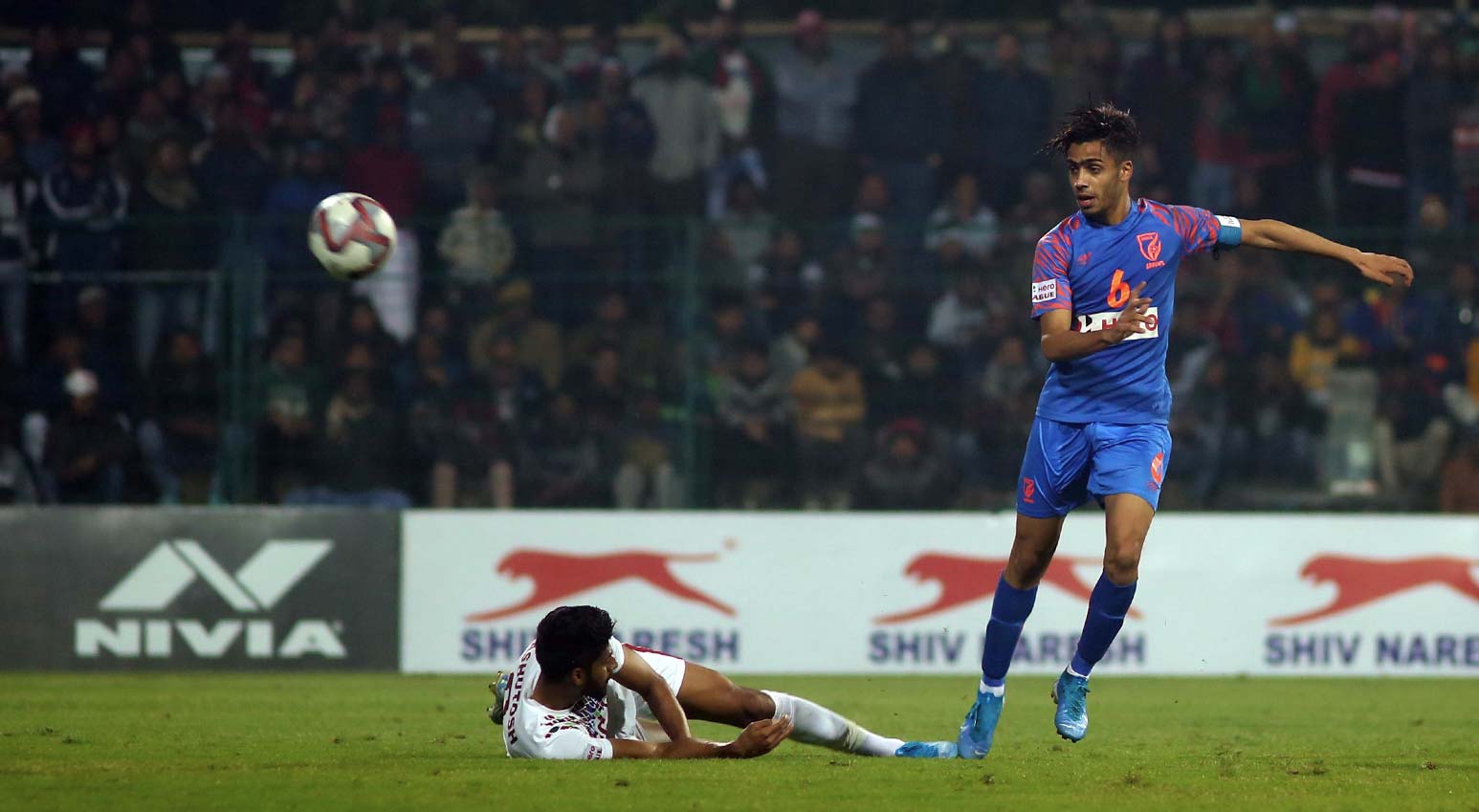Featured
Indian football’s top young talents — Vikram Partap Singh

With football coming to a standstill, and the season effectively coming to an end, The Bridge takes a look at the brightest young prospects of Indian football over the next one week or so. In this article, we take an in-depth look at the rise of India U-19 and Indian Arrows starlet Vikram Partap Singh who is poised to make a move to the Indian Super League (ISL) this season.
No player challenges our biases more in this country than Vikram Partap Singh. It is the pathway which is to blame. From starting his football career at a local football academy to climbing up the ranks through sheer hard work and determination, his journey so far plays a major role in the preconceived ideas forming around him.
If the picture isn’t clear enough already, trust me, it will be in a moment. He’s a kid of few words, who plays all across the front three in the swallow-necked blue and orange of team India and can produce the spectacular out of nothing. He will probably have his own cult following soon, who will sing “We’ve got Vikraam!” — hang on a minute? Is he the… No. No he isn’t. Proclaiming Vikram the new Sunil Chhetri is too easy, a little too convenient, even.
 The next Sunil Chhetri? (Source: AIFF)
The next Sunil Chhetri? (Source: AIFF)
It speaks to a couple of things. Let’s start with projection. Fans hope to see another Chhetri. Who wouldn’t? Football scouts, agents, journalists — everyone wants to say he is the second coming. It’s an easy sell to the various clubs in the market for Indian talents. You also probably need to start thinking about what bringing through a player dubbed the new Chhetri means to the All India Football Federation (AIFF). The chief football body in the country has often been criticised for things which are beyond their control. A prodigy coming through the ranks and potentially taking the current captain’s place in the national team will be a big thing for them.
All of this, though, hasn’t stopped India’s top clubs from elbowing each other out of the way to sign the 18-year-old talent. Kerala Blasters and East Bengal have kept abreast of the situation and want to be in the frame when he makes a decision about his future. “He has shown some potential over the last couple of seasons, it’s not hard to see he has got talent,” current India U-19 and Indian Arrows coach Venkatesh Shanmugam tells The Bridge. Well, when he was a kid, just kicking the ball around, it wasn’t hard either.
**
“He used to be a very restless child,” Gurcharan Singh, Vikram’s chacha — the man who inspired Vikram to take up football — recollects. “He was never interested in studies, not even a single bit. When he was young, he was always up to some mischief or the other, you could say he was naughty but that would be an understatement,” he laughs before adding, “I figured this energy should be channelled elsewhere and thus, got him a football.”
Sports runs in the veins of the family. For Vikram, football was almost as if second nature and Gurcharan saw his nephew’s interest in the game, his ‘junoon’. At that time he was moving to Chandigarh from his village Gurudaspur in Punjab, and he had a feeling that the kid could someday become a star. He decided it would be best for Vikram to move to the city with him and enroll in an academy — the Chandigarh Football Academy (CFA) — that, over the years, has given India more than 50 international footballers.
https://www.youtube.com/watch?v=j-H1fsE7GT0
Vikram, all of 7 years old at that time, did not hesitate much even though it meant he would have to leave his parents and live with his uncle in an unknown city. After all, he would get to play football most of the time and not worry about reading and writing and stuff. “I felt we had to take a risk. Either force him to do something he did not like much, or make football a priority. Now, thanks to God, I think I made the right decision then,” says Gurcharan.
However, easy as it was to plan, he found out that getting a child into CFA was quite a difficult ask. “Unfortunately, when I first took Vikram to CFA, they did not pay a single heed. I was told that there was a procedure, each player has to come through trials and the trials only happened on specific dates,” he recalls. “When I say unfortunately, I mean it was unfortunate for them because two years later, they would have to take him in anyway.”
As with a lot of things though, rejection didn’t faze Gurcharan, he admitted his ward at a school which was known for its football team. Then, he convinced a coach from the same school to train Vikram privately. Two years later, in 2011, when he felt Vikram was ready, he took him to the CFA trials. A cut above the rest, the youngster stood out. “Hundreds of kids had come for the trials, from all over the country and they would only take four players. But Vikram excelled, he was selected and since that day, we knew there was no point in looking back,” says Gurcharan.
**
There, amidst the hustle and bustle of city life, Vikram’s career started taking shape. Under the watchful eyes of former India international Harjinder Singh and Sandeep Singh, the youngster polished his trade. At first, he used to play in midfield in the different age-division teams (later on, he was asked to play up front). Even then, he loved to carry the ball forward; he was good with both his feet and never shied away from a challenge. The day was not far away when he would be called up by the AIFF.
It was 2014 and the AIFF had selected a pool of players born in the year 2002 for a selection trial. The players meeting up in Sports Authority of India (SAI), on the leafy outskirts of Bhopal, had either never been part of the international set-up before or had only played one or two games for the age-group teams of India.
 Good with both feet, Vikram can play anywhere across the front three (Source: Facebook / Vikram Partap Singh)
Good with both feet, Vikram can play anywhere across the front three (Source: Facebook / Vikram Partap Singh)
The purpose of the exercise was simple enough. The AIFF are thorough at the best of times but the one thing they did not want — given the U17 FIFA World Cup was round the corner — was to miss out on any prospect, particularly those flying under the radar. Vikram, for instance, did not represent India until Bibiano got to see him over the course of this selection trial.
Scott decided it would be best to split up the boys into four teams and hand them over the respective coaches. As luck would have it, Vikram ended up in Bibiano’s team. When Bibiano first saw Vikram in that camp, he was surprised to see how mature the youngster was. There was something about his fighting spirit on the pitch that caught the Goan coach’s eye and due to his performances, he was selected for the Tajikistan tour.
The AIFF started taking a closer interest and not too long afterwards, Vikram, burst on the scene with India U16, when Bibiano was reunited with him. He excelled at the SAFF Championships, scoring a hattrick against Jordan and a stunner against Nepal. “As a striker you have to take half-chances and try and score a goal,” Vikram had told Football Counter back at that time.
His exploits would continue at the AFC U16 Qualifiers and then, at the AFC U16 Championships, where Vikram scored India’s only goal in their run to the quarterfinals. He’s mainly right-footed but even in those days, he’d use his left and get the team up the pitch with great fluidity.
In between, Vikram also played at the Minerva Punjab academy, where he moved to after leaving CFA, for about three seasons, and, in fact, helped them win a couple of trophies as well. However, by his own admission to Goal.com, Minerva didn't have much of a role to play in his development.
**
Once he turned 17, the natural progression was to move to the U19 setup, or in essence the Indian Arrows setup which gave him an opportunity to play in the I-League. While his first season was one to forget — Vikram managed only one goal in 13 appearances — through the 2019-20 season, the teenager proved that he is quite capable of holding his own against more experienced players.
 Vikram Partap takes on East Bengal defenders (Source: AIFF)
Vikram Partap takes on East Bengal defenders (Source: AIFF)
Playing regularly in the top flight presented Vikram with a different, more exacting challenge, and not just because he was up against teams like East Bengal and Mohun Bagan. By the time he was set to make his I-League debut, he was already a known face in the Indian football fraternity, thanks to his showings for India U16. Moreover, the Arrows, perhaps unsurprisingly, are among the lowest scoring teams around, which means scoring chances are harder to come by. We are talking an average of less than 0.44 goals scored per match this season, the lowest in I-League. They have had just 22 shots on goal, but guess what — Vikram scored four of the seven goals the Arrows tallied this season.
Arrows’ playing style makes it hard for Vikram to play as a pure attacker — the classic role associated with Chhetri. Employed mostly down the right wing, he does not impose himself on games through scoring and scoring alone. The lanky boy has a knack for helping out his teammates in defence as well. Nevertheless, Vikram, mainly due to his blistering pace and sheer force, is a threat whenever he has the ball at his feet in the attacking third.
“Besides his obvious natural ability, I think the AIFF deserve great credit for the manner with which they’ve developed Vikram,” Gurcharan concedes. “At CFA, he would still be mischievous… playing pranks, sneaking out at night, but all that changed at AIFF. Now, you see I don’t understand the technicalities that much, but if something has changed about him, it is the fact that now he is more disciplined, focussed and dedicated. Also, I think Vikram has good leadership qualities and can be a good captain.”
I know what you’re thinking. Vikram's appearance not only seems like Chhetri — the attitude Gurcharan is describing sounds a lot like Chhetri too. But Vikram’s coach at Arrows gives the notion short shrift. “It’s an absolute wrong comparison,” Shanmugam insists. “Sunil is where he is. Vikram’s career hasn’t yet kicked-off. Though Vikram has a lot of potential, we cannot be drawing these comparisons. He is young, and has a long way to go. He is very disciplined, and discipline is a wealth you cannot buy.”
**
On the back of his performances this season, Vikram has been named in the list of nominees for the Men's Emerging Player of the Year award. Though nominated for the prestigious award alongside heavyweight names like Anirudh Thapa, Sumit Rathi amongst others — a source of understandable pride for the young Punjabi boy — it must still feel like a case of the bandwagon being put in front of the horse. He knows he is yet to make a true, indelible mark and a move to the ISL beckons.
 Vikram Partap has attracted big ISL clubs (Source: AIFF)
Vikram Partap has attracted big ISL clubs (Source: AIFF)
Vikram Partap Singh, in recent times, has become one of the most gossiped-about players in India’s sports dailies, not to mention on social media. Everyone wants to know his next move, and that next move is so essential — for, if you make the wrong move, you may end up wasting and dithering on the vines of the big clubs. Komal Thatal, Boris Singh Moirangthem, and so many others have gone down that road. On the other hand, the likes of Amarjit Singh Kiyam, Nongdamba Naorem have shown there are different pathways to establishing one self in Indian football.
Former India U19 and Arrows coach Floyd Pinto had explained just how difficult it is to make the cut in an interview a couple of weeks back. “It’s not always about if the boys are good enough, because they are. It’s about making the right decision,” he said. “Sometimes, you may not play regularly in a season, but training with professionals helps you gain a lot of experience. And then, in the second season, you get a chance to prove yourself. You may give your best and still, not get any game time, it’s survival of the fittest, it’s cruel, it’s competitive, that’s professional football for you.”
The way he has been handling the situation, though, speaks volumes of Vikram. While offers have landed at his feet from almost every big club in the country, he is still carefully and patiently considering his options. People will ask, hypothetically, if everything goes alright, can he be the next Sunil Chhetri?
“Vikram is a hard worker. You just have to look at his fighting spirit on the pitch to realise that. If he continues to work hard, he does have a bright future,” believes Shanmugam. Gurcharan, also, mirrors the same thought, he says, “I am sure he will do big things for the country, he will.”
Wherever he ends up, one thing is clear — Vikram Partap isn’t the next Chhetri. But guess what — we’ll probably be back here in 10 or 15 years’ time asking: “Who is the next Vikram Partap?”






